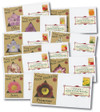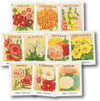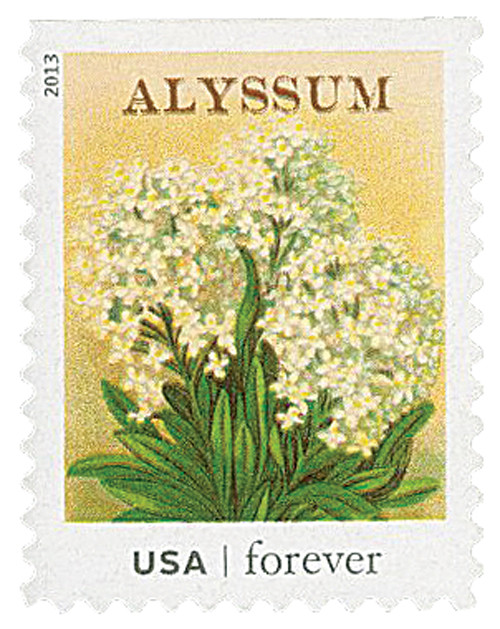
# 4754-63 - 2013 First-Class Forever Stamp - Vintage Seed Packets
U.S. # 4754-63
2013 46¢ Vintage Seed Packets
Set of 10
To a gardener, every package of flower seeds is a new beginning – a chance to nurture something and be rewarded with bursts of color from nature’s palette. Packets usually feature tips on how to plant the seeds, giving beginners and experts alike the chance to add a dash of color to their backyards and patios. Once a few fundamentals are understood, it becomes easy to adapt those recommendations to suit a range of special situations.
Perennials are ornamental plants that do not die after one season, while annuals complete their life cycle in a single season. Because they need to be replaced yearly, a bed of annual flowers can take on a new look every year just by selecting different varieties and colors. Other plants drop seeds into the soil, where they germinate and become a new “generation” as the original dies off.
Two of the largest factors in gardening are temperature and sun. The U.S. Department of Agriculture developed a hardiness zone map based on minimum temperatures. This system takes the guesswork out of choosing plant varieties that are ideal for each climate. Regardless of the air temperature, some flowers require sun all day to put forth boldly colored blossoms, while others need shade to survive. Balancing all of these elements may sound complicated, but they can be fun to experiment with and are easily mastered.
U.S. Postal Service art director Antonio Alcala designed the 10 Vintage Seed Packet stamps. He based these designs on photographs from 1910s and 1920s seed packets. Seven of the images were based on seed packets produced for the William D. Burt Seed Co. of New York. The other three (primrose, calendula, and linum) were designed for Everitt’s Seed Store in Indiana.
Value: 46¢ First-Class letter rate
Issued: April 5, 2013
First Day City: Oaks, PA – Philadelphia Stamp Exhibition
Type of Stamp: Definitive
Printed by: Avery Dennison
Method: Photogravure printing in double-sided panes of 20 (convertible booklet format)
Perforation: Die Cut 10 ¾
Self-Adhesive
Quantity Printed: 400,000,000 stamps
Though not an established series, flowers have long been a popular subject for U.S. stamps. One of the earliest issues to feature a flower as a prominent design subject was U.S. #977, honoring Moina Michael, the founder of Poppy Day.
U.S. # 4754-63
2013 46¢ Vintage Seed Packets
Set of 10
To a gardener, every package of flower seeds is a new beginning – a chance to nurture something and be rewarded with bursts of color from nature’s palette. Packets usually feature tips on how to plant the seeds, giving beginners and experts alike the chance to add a dash of color to their backyards and patios. Once a few fundamentals are understood, it becomes easy to adapt those recommendations to suit a range of special situations.
Perennials are ornamental plants that do not die after one season, while annuals complete their life cycle in a single season. Because they need to be replaced yearly, a bed of annual flowers can take on a new look every year just by selecting different varieties and colors. Other plants drop seeds into the soil, where they germinate and become a new “generation” as the original dies off.
Two of the largest factors in gardening are temperature and sun. The U.S. Department of Agriculture developed a hardiness zone map based on minimum temperatures. This system takes the guesswork out of choosing plant varieties that are ideal for each climate. Regardless of the air temperature, some flowers require sun all day to put forth boldly colored blossoms, while others need shade to survive. Balancing all of these elements may sound complicated, but they can be fun to experiment with and are easily mastered.
U.S. Postal Service art director Antonio Alcala designed the 10 Vintage Seed Packet stamps. He based these designs on photographs from 1910s and 1920s seed packets. Seven of the images were based on seed packets produced for the William D. Burt Seed Co. of New York. The other three (primrose, calendula, and linum) were designed for Everitt’s Seed Store in Indiana.
Value: 46¢ First-Class letter rate
Issued: April 5, 2013
First Day City: Oaks, PA – Philadelphia Stamp Exhibition
Type of Stamp: Definitive
Printed by: Avery Dennison
Method: Photogravure printing in double-sided panes of 20 (convertible booklet format)
Perforation: Die Cut 10 ¾
Self-Adhesive
Quantity Printed: 400,000,000 stamps
Though not an established series, flowers have long been a popular subject for U.S. stamps. One of the earliest issues to feature a flower as a prominent design subject was U.S. #977, honoring Moina Michael, the founder of Poppy Day.


















